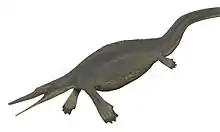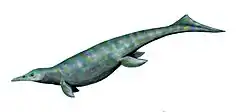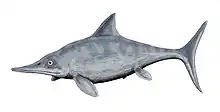Shonisaurus
Shonisaurus is a genus of ichthyosaur. At least 37 incomplete fossil specimens of the marine reptile have been found in the Luning Formation of Nevada, USA. This formation dates to the late Carnian age of the late Triassic period, about 237-227 million years ago.[2]
| Shonisaurus | |
|---|---|
 | |
| Restored skull in a Japanese museum | |
| Scientific classification | |
| Kingdom: | Animalia |
| Phylum: | Chordata |
| Class: | Reptilia |
| Order: | †Ichthyosauria |
| Family: | †Shonisauridae |
| Genus: | †Shonisaurus Camp, 1976 |
| Species: | †S. popularis |
| Binomial name | |
| †Shonisaurus popularis Camp, 1976 | |
Description

Shonisaurus lived during the Carnian stage of the late Triassic period. S. popularis measured around 15 metres (49 ft) long. A second species from British Columbia was named Shonisaurus sikanniensis in 2004. S. sikanniensis was one of the largest marine reptiles of all time, measuring 21 metres (69 ft). However, phylogenetic studies later showed S. sikanniensis to be a species of Shastasaurus rather than Shonisaurus.[3] A new study published in 2013 reasserted the original classification, finding it more closely related to Shonisaurus than to Shastasaurus.[4] Specimens belonging to S. sikanniensis have been found in the Pardonet Formation British Columbia, dating to the middle Norian age (about 210 million years ago).[2]
Shonisaurus had a long snout, and its flippers were much longer and narrower than in other ichthyosaurs. While Shonisaurus was initially reported to have had socketed teeth (rather than teeth set in a groove as in more advanced forms), these were present only at the jaw tips, and only in the very smallest, juvenile specimens. All of these features suggest that Shonisaurus may be a relatively specialised offshoot of the main ichthyosaur evolutionary line.[5] It was historically depicted with a rather rotund body, but studies of its body shape since the early 1990s have shown that the body was much more slender than traditionally thought.[6] S. popularis had a relatively deep body compared with related marine reptiles.[2]
Shonisaurus was also traditionally depicted with a dorsal fin, a feature found in more advanced ichthyosaurs. However, other shastasaurids likely lacked dorsal fins, and there is no evidence to support the presence of such a fin in Shonisaurus. The upper fluke of the tail was probably also much less developed than flukes found in later species.[7]
History

Fossils of Shonisaurus were first found in a large deposit in Nevada in 1920. Thirty years later, they were excavated, uncovering the remains of 37 very large ichthyosaurs. These were named Shonisaurus, which means "lizard from the Shoshone Mountains", after the formation where the fossils were found.
S. popularis, was adopted as the state fossil of Nevada in 1984. Excavations, begun in 1954 under the direction of Charles Camp and Samuel Welles of the University of California, Berkeley, were continued by Camp throughout the 1960s. It was named by Charles Camp in 1976.[8]
The Nevada fossil sites can currently be viewed at the Berlin-Ichthyosaur State Park.
Bonebed interpretation
The Nevada bonebed represents a large assemblage of Shonisaurus which died at varying times and became preserved on the sea floor in a curiously regular arrangement of bones. The lack of fossil invertebrates encrusting the remains indicates that the carcasses sank in relatively deep water poor in oxygen.
See also
- Largest prehistoric organisms
- Shastasaurus, a relative of Shonisaurus
- Temnodontosaurus, another large ichthyosaur
- List of ichthyosaurs
- Timeline of ichthyosaur research
Notes
- "†Shonisaurus Camp 1976 (ichthyosaur)". Paleobiology Database. Fossilworks. Retrieved 11 August 2017.
- Nicholls, Elizabeth L.; Manabe, Makoto (2004). "Giant Ichthyosaurs of the Triassic—A New Species of Shonisaurus from the Pardonet Formation (Norian: Late Triassic) of British Columbia". Journal of Vertebrate Paleontology. 24 (4): 838–849. doi:10.1671/0272-4634(2004)024[0838:GIOTTN]2.0.CO;2. ISSN 0272-4634.
- Sander, P. Martin; Chen, Xiaohong; Cheng, Long; Wang, Xiaofeng (2011). Claessens, Leon (ed.). "Short-Snouted Toothless Ichthyosaur from China Suggests Late Triassic Diversification of Suction Feeding Ichthyosaurs". PLOS ONE. 6 (5): e19480. Bibcode:2011PLoSO...619480S. doi:10.1371/journal.pone.0019480. PMC 3100301. PMID 21625429.
- Ji, C.; Jiang, D. Y.; Motani, R.; Hao, W. C.; Sun, Z. Y.; Cai, T. (2013). "A new juvenile specimen of Guanlingsaurus (Ichthyosauria, Shastasauridae) from the Upper Triassic of southwestern China". Journal of Vertebrate Paleontology. 33 (2): 340. doi:10.1080/02724634.2013.723082. S2CID 83784699.
- Palmer, D., ed. (1999). The Marshall Illustrated Encyclopedia of Dinosaurs and Prehistoric Animals. London: Marshall Editions. pp. 78–79. ISBN 1-84028-152-9.
- Kosch, Bradley F. (1990). "A revision of the skeletal reconstruction of Shonisaurus popularis (Reptilia: Ichthyosauria)". Journal of Vertebrate Paleontology. 10 (4): 512–514. doi:10.1080/02724634.1990.10011833.
- Wallace, D.R. (2008). Neptune's Ark: From Ichthyosaurs to Orcas. University of California Press, 282pp.
- Hilton, Richard P., Dinosaurs and Other Mesozoic Animals of California, University of California Press, Berkeley 2003 ISBN 0-520-23315-8, at pages 90-91.
References
- Dixon, Dougal. "The Complete Book of Dinosaurs." Hermes House, 2006.
- Camp, C. L. (1980). "Large ichthyosaurs from the Upper Triassic of Nevada". Palaeontographica, Abteilung A. 170: 139–200.
- Camp, C.L. 1981. Child of the rocks, the story of Berlin-Ichthyosaur State Park. Nevada Bureau of Mines and Geology special publication 5.
- Cowen, R. 1995. History of life. Cambridge, Massachusetts: Blackwell Scientific.
- Hogler, J. A. (1992). "Taphonomy and Paleoecology of Shonisaurus popularis (Reptilia: Ichthyosauria)". PALAIOS. 7 (1): 108–117. Bibcode:1992Palai...7..108H. doi:10.2307/3514800. JSTOR 3514800.
- McGowan, Chris; Motani, Ryosuke (1999). "A reinterpretation of the Upper Triassic ichthyosaurShonisaurus". Journal of Vertebrate Paleontology. 19: 42–49. doi:10.1080/02724634.1999.10011121.
- Motani, Ryosuke; Minoura, Nachio; Ando, Tatsuro (1998). "Ichthyosaurian relationships illuminated by new primitive skeletons from Japan". Nature. 393 (6682): 255–257. Bibcode:1998Natur.393..255M. doi:10.1038/30473. S2CID 4416186.



